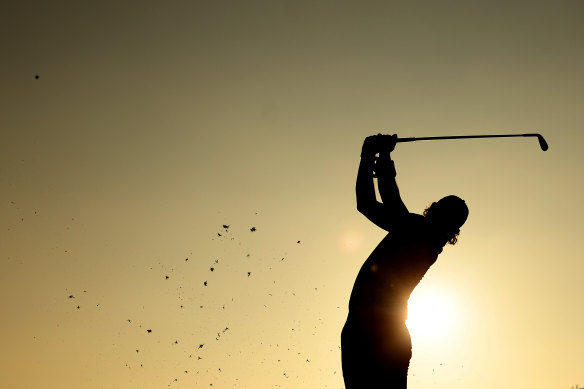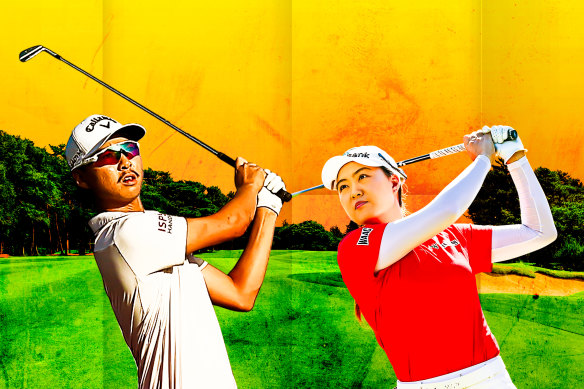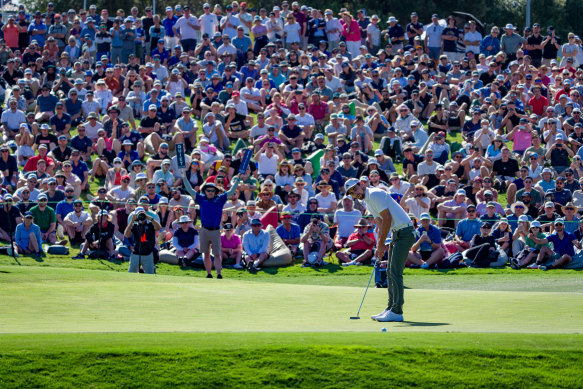This was published 10 months ago
The Australian Open has a dilemma: can men and women keep playing together?
By Adam Pengilly
The viability of the Australian Open, golf’s first national championship to have men and women playing alongside each other, is under increasing pressure with no venue announced for this year’s event and a number of prestigious courses hesitant to host it.
Just five months out from the 2024 tournament, Golf Australia is yet to announce where the Australian Open will be played as it battles logistical hurdles and state governments slashing major event budgets, which has left players reluctant to commit to one of the sport’s most historic events.
Sources not authorised to speak publicly about the matter given the confidential negotiations said Melbourne remained the frontrunner to snatch the Australian Open from Sydney. Kingston Heath is the leading candidate.
But with Victorian Premier Jacinta Allan trying to unshackle the state from $135 billion in net debt and golf-loving Dan Andrews out of office – the state is already tipping in to host the Presidents Cup in 2028 and 2040 – negotiations have been delicate.
Since announcing its first gender equity event in 2022, both the men and women have played for $1.7 million purses at the Australian Open, which requires a significant underwriting and government assistance.
But proponents argue it’s better than the alternative. When they were run as separate events, Golf Australia’s tournament expenses were greater. Commercial partners have also lobbied for both genders to play at the same time.

Cameron Smith of Australia plays a shot on the practice range prior to the Australian Open at The Lakes in SydneyCredit: Mark Metcalfe/Getty Images
Complicating matters is the massive task of staging an event with 240 men and women teeing up, requiring two championship-calibre courses, preferably within a short distance of each other, to allow players, officials and fans to commute between each during the opening two rounds and practice days.
Sydney’s The Australian Golf Club was the primary venue for last year’s tournament – which was well attended, had soaring television audiences and featured a thrilling climax when Joaquin Niemann won the men’s event as darkness closed in with a play-off victory on the second extra hole. The Lakes supported The Australian on the Thursday and Friday before the 36-hole cut.
But exclusive courses that charge members tens of thousands of dollars in annual fees are increasingly reluctant to commit to the event, particularly if they’re not the main weekend venue.
The rise in popularity of Greg Norman’s LIV Golf, which has signed a four-year deal with the South Australian government and had more than 90,000 fans flock to The Grange over three days in April, has also limited Golf Australia’s options as far as the search for a host state.
Queensland has become the home of the Australian PGA Championship, and after the NSW government’s deal to host the Australian Open expired last year, it has shied away from making another long-term offer.
It leaves Victoria in pole position, but at what cost?
“Last year was a great success and a fantastic event at The Australian and The Lakes, and to see the atmosphere, particularly on the weekend with over 60,000 people attending and some fantastic TV audiences to go with it, we were extremely pleased with how the event came together,” Golf Australia chief executive James Sutherland said.
“We’re super optimistic about what the event will look like in 2024. Whilst we haven’t yet made any decisions or announcement about venues, we’re very confident we’ll have wonderful and fitting venues.”

Min Woo and Minjee Lee.Credit: Illustration: Stephen Kiprillis
Having the likes of Australia’s new golfing rock star Min Woo Lee playing in a group adjacent to his sister, two-time major winner Minjee Lee, has been a promoter’s dream for the Australian Open, while also allowing the stars of the women’s game greater exposure to on-course and television audiences, fuelled by the post-COVID boom in popularity of golf.
“I love playing in Australia and the crowds are the best,” Min Woo Lee said. “To play with my sister is unbelievable. To have the family together in one spot is a big deal for us as golfers. It’s amazing.”
And the importance of the Australian Open was highlighted when Joaquin Niemann, a star on Norman’s breakaway LIV Golf, was issued a special invite to The Masters, largely on the back of his win in Sydney last year.
He didn’t meet any of Augusta National’s qualifying criteria, but chairman Fred Ridley spoke about the importance of the Chilean’s win in the Australian Open, a move that went some way to easing tensions in professional golf’s civil war.
“The Australian Open is a tournament that has a lot of history,” Niemann said. “You look back over the years and see all the names that are there, it’s a very special trophy. I feel like that’s why they went with [a special invitation]. The Masters is all about history and prestige, and the Australian Open has that.”
Former Ryder Cup captain Paul McGinley went a step further: he said the winner of the Australian Open should be granted automatic entry to the four majors.
It echoed four-time major winner Rory McIlroy’s comments on the stature of the event, which has been won by a who’s who of men’s golf: Gene Sarazen, Jack Nicklaus, Arnold Palmer, Gary Player and Norman. Karrie Webb has won the women’s event five times.
McIlroy maintains he wants to return for an Australian Open (he won it at Royal Sydney in 2013), particularly if it’s at Kingston Heath. But there’s a catch: sources not authorised to speak about the matter publicly said he commanded an appearance fee exceeding $1 million, money the tournament simply cannot afford.
Instead, it forges ahead with a focus on luring the best Australians home, such as Cameron Smith, Adam Scott, Marc Leishman, the Lee siblings and Hannah Green, some of whom also command money just to tee up.
Multiple agents, who asked to remain anonymous to speak freely, said at The Masters they were given little indication from Australian golf officials of where the Australian Open would be held this year.
But even catching the stars on the broadcast when they’re here can be problematic.
A streamlined production last year was limited to roving cameras following the leading groups on the weekend – there were no fixed ones on each hole – and it ignored tournament drawcards Smith and Scott in the third round, although the pair were down the leaderboard.
And with so many players across both genders required to play on the final day, tee times were staggered in morning and afternoon waves across the first and 10th tees.

Joaquin Niemann wowed fans during his Australian Open success last year.Credit: Getty
When Scott made an unlikely final day charge last year after starting his round on the back nine, production crews were forced to scramble to the other side of the course and didn’t catch up with him until the final four holes of his round, which finished hours before the last groups. When they got there, he made a disastrous triple-bogey seven and that was that.
“It has been a bit different the last couple of years with everyone playing together,” Smith said. “But I think last year was better than the year before [2022 in Melbourne]. I hope they start trying to figure some things out because there’s definitely some weird stuff that goes on over the weekend with the morning and afternoon draw. I don’t particularly like that, but they’ll get it eventually.”
It has led to complaints from players, who insist a rival starting on the same score in the final round, for example, might tee off hours earlier and have better conditions due to the task of trying to have so many men and women play.
There had been teething issues in the first year. Some men’s players were critical of the course set-up and the pace of play, as well as the contentious double cut, which absented Smith on the final day. Tournament organisers responded by reducing the women’s field and restoring a single cut.
“Ultimately, we feel the format is appropriate for what we want for the game, and we will continue to review it and improve it,” Sutherland said. “We need to make decisions in the best interests of Australian golf and the tournament itself.”
Smith’s LIV Golf teammate Lucas Herbert said he empathised with the limited staff and resources afforded to the Australian Open but he said the tournament needed to assess what it wanted to be: an elite men’s event chasing the biggest names in the world or the current concept, which is a celebration of both genders, but which has operational challenges.
The late November-early December date also has mixed reviews, better suiting the men rather than the women, who travel to Australia immediately after a gruelling LPGA Tour season.
“Having the women on the same stage as the men is obviously so good for women’s golf to inspire young girls to play the sport,” said WPGA Tour of Australasia chief executive Karen Lunn. “To think they can be on the same course as Adam and Cam, for me, any of the issues are outweighed by the benefits.
“For our girls, it is the end of a long year, but it’s up to us to educate them it’s so good for the game in Australia. It might not be the preferred date, but we have to run with it.”
Sports news, results and expert commentary. Sign up for our Sport newsletter.